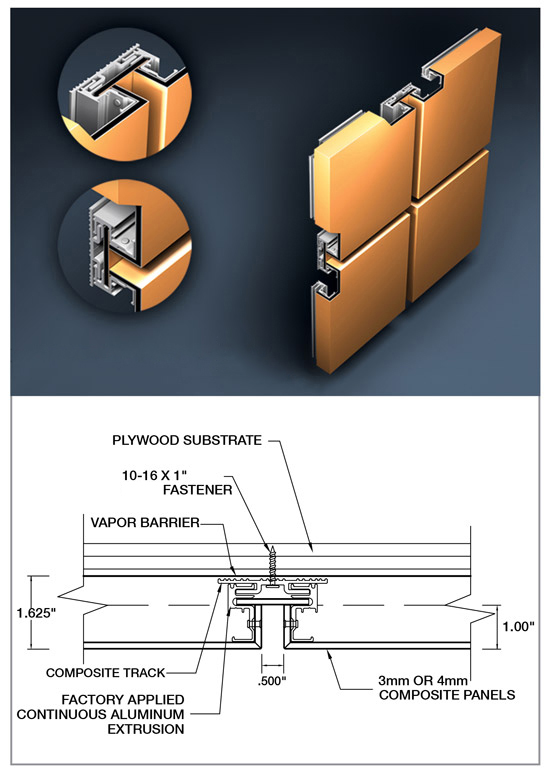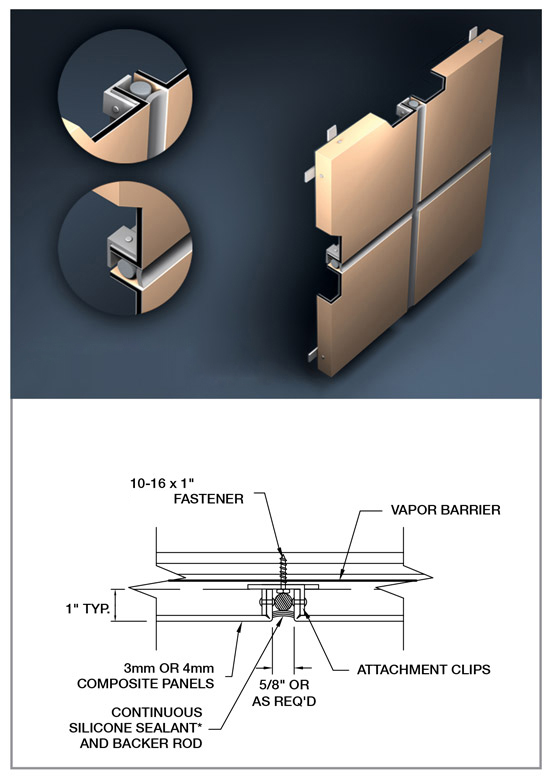Metal Exterior Walls
Exposed Fastener Panels
Exposed Fastener Panels provide the most flexibility for use in wall, interior and linear panel applications. They are a cost-efficient yet architecturally appropriate metal panel solution in many cases. Available in several coverage widths, exposed fastener panel profiles are available in a full range of gauges and materials. Exposed fastener panels can also be produced in a perforated pattern for a variety of exterior projects, such as equipment screens or for interior acoustical applications. Manufacturer's technical staff can be a resource to review exposed fastener panel options including panel material selection, finish specification, and budgeting.
Composite Wall Panels
Metal Composite Material (MCM) panels combine some of the strong aesthetics of flush panels with the rigidity of corrugated panels. Typically, MCM panels create a smooth, sleek look that can be bent, curved and joined together in an almost limitless range of geometric configurations. Originally called aluminum composite materials (ACM), the name of the product category changed to metal composite materials to reflect the introduction of other skin metals, such as zinc, copper, stainless steel, and titanium. Aluminum, however, remains the predominant skin material in use.


Images courtesy of Petersen Aluminum / PAC-CLAD
Composite metal wall panels are flat and lightweight using two layers of metal with an engineered plastic layer in between.
The Metal Construction Association notes that MCM panels have been used in North American construction projects for nearly 30 years and the market trends show their use to be increasing more and more. They are formed by bonding two metal skins to a highly engineered plastic core (polyethylene or fire-retardant plastic) placed between them, creating a thin "sandwich" panel. The bonding process necessarily occurs under very precise conditions of temperature, pressure and tension. Some panels are formed by a rout and return process utilizing computer controlled routing equipment. This state-of-art fabrication insures tight tolerances and accurate panel dimensions. The result is a metal/plastic composite sheet that provides numerous benefits compared to a similar thickness of a solid metal sheet. For example, MCM sheets are flat when manufactured and have been proven to stay flat after installation. There is no "oil canning" or wrinkling because the skins are bonded to the core. MCMs also provide a wide variety of finish since aluminum and steel MCMs are available in virtually any color a building owner or architect wishes. Current paint application technology helps to ensure that the finish remains consistent between panels eliminating the possibility of a checkerboard appearance of mismatched panels on the building's exterior.
While strong aesthetics is one reason for the popularity of MCMs affordability is another. When first introduced, MCMs were limited to use on high end projects but improvements in manufacturing technology, efficiencies in installation and good old fashioned competition have made these panels very cost-competitive. Construction costs are often lower with MCM panels because they can be installed faster than alternative exterior skins and their light weight reduces structural requirements. All of this means that MCM panels are found on a wide variety of building types and metal building applications, ranging from wall panel systems on major projects to cornices and canopies on smaller ones.
Properly designed and installed, MCM panels provide a very reliable and versatile building skin. MCM manufacturers commonly produce the high quality metal sheets in a wide variety of lengths and widths. It is the metal fabricators however who change the flat sheets into panels that are custom sized and suited for use in particular buildings. In some cases, the fabricators may also install the system. Typically staggered angle clips mounted to the panels allow for each panel to be installed and adjusted individually in the field for a proper fit.









